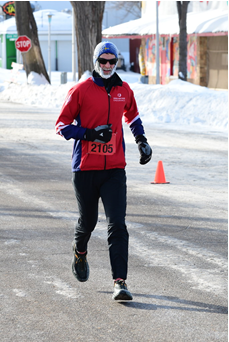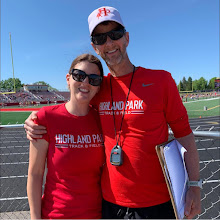Both feet (barely) off the ground.
As January comes to a close, I like to think I followed my “master plan” for the month. The idea was to;
11 1) build mileage at the end of December and into
the first week of January – I ended up with 38, 43 and 49 miles during that stretch.
2) take a down week and race on the 14th
– backed off to 28 miles and ran a decent 5M race.
3) build mileage for the next 2 weeks before racing
on the 29th – had back-to-back 7-day stretches of 47 and 54 miles
(note: I say 7-day stretches because they were from Monday to Sunday, which isn’t
my typical Sunday to Saturday “week”. I did race yesterday – more on that
below.
4) backing off for a couple of weeks before jumping
into marathon training – that’s where I’m at now.
I also tried to keep things fun by including 3 fat bike rides
and 4 skis, along with 8 strength sessions. Overall, I’m happy with where I’m
at and my plan moving forward. That plan being the Level 3 version from 8020endurance.com.
I originally downloaded their Level 2 plan, but then David Goggins was whispering
in my ear, “Go big or go home.” In reality, I’ll probably have both plans
side-by-side and try to follow a combination of both.
I feel like I need to caveat a lot of my posts with “back when
I was more focused on road racing…” because it’s been so long that that has
been my focus. But back when I was more focused on road racing, I always looked
forward to winter running as a chance to put in a lot of miles and build a base
heading into spring. During most winters, this base building phase included me
running the Winter Carnival half marathon as a way to benchmark my progress. All
those years the race started in downtown St. Paul and was basically an
out-and-back on Shepard Road, which is a 4-lane road with clear surfaces (as
long as it wasn’t snowing at the time) and rolling hills. In addition, there
was also plenty of competition and people to run with.
This year’s race was held on at the State Fair grounds and
you had the option of running 1 – 4 laps that were supposed to be 5K. I signed
up for the 20K option with the hopes that the closed-off fair grounds would
include dry pavement. That turned out not to be the case. Just walking across
the parking lot was a challenge with all the glare ice. After picking up my bib
I looked at the start/finish area and could tell that the roads were not plowed
very well. I initially had my racing shoes on, but even prior to warming up I
knew those wouldn’t be a wise choice. I switched to my trail shoes and changed
my mindset from “racing” to just getting in a solid effort. It turned out that
there were about 1 mile of clear roads during each loop. Otherwise, we were
running on packed snow or ice covered in sand.
The 15K and 20K started together with 18 and 44 people
running those respective events, with he 5K and 10K starting 5 minutes later. When
the gun went off, I followed my latest strategy of running without looking at
any splits. There was an 8-minute pacer just in front of me for the first lap,
but he eventually gapped me. After about 1.5 laps we started lapping runners
from the other events, so although it was a pretty boring course, there were a
lot more people on it than you’d expect from such a small event.
There really isn’t a lot to report from the race itself. It
was about -3 degrees at the start, so I was bundled up. I am curious how much
that affects a runner’s performance. There are lots of conversion charts for
things like altitude and heat, but I haven’t seen one for wearing 2 layers of
pants, a shirt, vest, and jacket, 2 layers of glove/mitts + hand warmers, and so
on. My guess is that it’s significant – at least that’s what I’m going with.
In my last race I had a guy pull away from me towards the end and he ended up winning our age group. During the last mile of this race, I caught 1 guy that was really struggling and was able to beat him to the finish line. As a result, I was the first 50–59-year-old and he was second. I won’t mention the fact that there was a 64-year-old about 8 minutes in front of me.
In the end, I was pleasantly surprised to finish in 1:35,
which is 7:40 pace for 20K. That was until I saw that my watch only recorded
11.7 miles – and that I averaged 8:08 pace. Recently I mentioned that I’m now
one of those runners that puts full stock into their watch. This is a prime
example of why I do that now. Granted my watch might not be perfect, but it’s not
.7 of a mile off. Honestly, being this far off is unacceptable. Maybe I’m too “Old
School” but when I run a race I want 2 things; 1) an accurate distance and 2) accurate
finish results. Heck, even #2 is debatable, because if I have #1, I can time myself.
I really don’t know who’s at fault here. Is it the Winter
Carnival committee who probably came up with the route and said, “that’s close
enough?” Or is it the timing company who probably just showed up and was told, “here’s
the start and finish line, don’t worry, we’ve marked the course?” I hate to
sound like an old curmudgeon, but around this area, all the classic races are
disappearing and being replaced by charity events. There’s nothing wrong with
having charity events, but they typically have much deeper pockets than the people
putting on the classics. As a result, the price to host a race goes up and
drives these people out of business. Then we’re left with race where the top
priority is swag and a DJ.
It’s time to put an emphasis on races with certified courses
– DJ’s be damned!
RECAP OF WEEK 1/15 – 1/21
Monday – AM: Strength + 2 mile easy, PM: 6 miles easy
Tuesday – 6 miles
Wednesday – AM: 6 miles, NOON: 4M fat bike
Thursday – AM: Strength + 2 mile easy, PM: 6 miles easy
Friday – 7-mile run w/ Scott
Saturday – Day off
Summary: 35 miles of running, 4 miles of biking, 7K of skiing and 2 strength training
RECAP OF WEEK 1/22 – 1/28
Monday – AM: Strength, PM: 8 miles easy
Tuesday – AM: 5 miles + strides, PM: 12K skate ski
Wednesday – 7.5 miles
Thursday – AM: Strength + 2 mile easy, PM: 6.5 miles w/ 6 x :30 hills
Friday – AM: 5.5 miles w/ Scott and Pat, PM: 2 miles easy
Saturday – AM: 5M fat bike, PM: 4 miles easy
Summary: 52 miles of running, 5 miles of biking, 12K of skiing and 2 strength training
Quote of the day;
“The best time to plant a tree was 20 years ago. The second best time is now.” - Chinese Proverb





